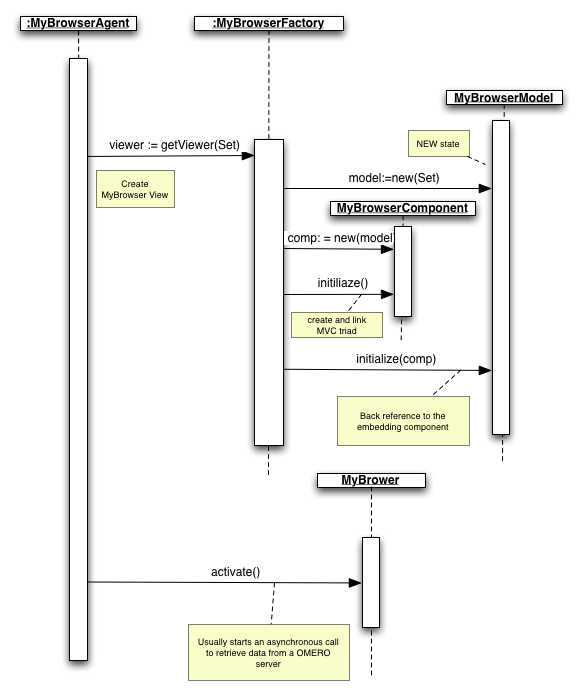Note
This documentation is for the new OMERO 5.4 version. See the latest OMERO 5.3.x version or the previous versions page to find documentation for the OMERO version you are using if you have not upgraded yet.
How to build an agent’s view¶
Note
With the release of OMERO 5.3.0, the OMERO.insight desktop client has entered maintenance mode, meaning it will only be updated if a major bug is discovered. Instead, the OME team will be focusing on developing the web clients. As a result, coding against this client is no longer recommended.
This section explains how a view of the agent is created. All our agents follow the same approach. To see the code while reading the notes, go to components/insight/SRC/org/openmicroscopy/shoola/agents/treeviewer/view.
Using the previous example MyBrowserAgent (see How to build an agent):
- Create a view package in the mybrowser package.
- Create the following classes MyBrowser (interface), MyBrowserComponent, MyBrowserModel, MyBrowserControl, and MyBrowserUI. If you browse the source code, you will notice that we usually have a class used as a toolbar and a class used as a status bar. Both classes are initialized by the BrowserUI. For clarity, they have been omitted in the following diagram.
- Create a MyBrowserFactory. This class keeps track of the MyBrowser instances created and not yet discarded. A component is only created if none of the tracked ones is displaying the data, otherwise the existing component is recycled.

OMERO.insight agent view
Typical life-cycle of an agent view¶
The object is first created using the MyBrowserFactory
//Somewhere in the MyBrowserFactory code
/** The sole instance. */
private static final MyBrowserFactory singleton = new MyBrowserFactory();
/**
* Returns a viewer to display the specified images.
*
* @param images The <code>ImageData</code> objects.
*/
public static MyBrowser getViewer(Set<ImageData> images)
{
MyBrowserModel model = new MyBrowserModel(images);
return singleton.getViewer(model);
}
/**
* Creates or recycles a viewer component for the specified
* <code>model</code>.
*
* @param model The component's Model.
* @return A {@link MyBrowser} for the specified <code>model</code>.
*/
private MyBrowser getViewer(MyBrowserModel model)
{
Iterator v = viewers.iterator();
MyBrowserComponent comp;
while (v.hasNext()) {
comp = (MyBrowserComponent) v.next();
if (model.isSameDisplay(comp.getModel())) {
comp.refresh(); //refresh the view.
return comp;
}
}
comp = new MyBrowserComponent(model);
comp.initialize();
comp.addChangeListener(this);
viewers.add(comp);
return comp;
}
After creation, the object is in the MyBrowser#NEW state and is waiting for the MyBrowser#activate() method to be called. Such a call usually triggers loading of the objects on the server. The object is now in the MyBrowser#LOADING state. After all the data have been retrieved, the object is in the MyBrowser#READY state and the data display is built and set on screen.
When the user quits the window, the MyBrower#discard() method is invoked and the object transitions to the MyBrowser#DISCARDED state. At which point, all clients should de-reference the component to allow for garbage collection.

OMERO.insight agent view initialization